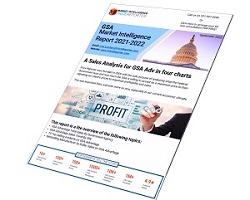Getting a GSA MAS contract might seem tough, but it comes with big chances for companies. Think of it like a door opening to a huge market. The government is on the lookout for the best companies to team up with. But there's a catch – you need to put together a strong GSA Price Proposal Template that stands out from the rest. It's like showing why you're the best pick for the job. This proposal consists of several sections, including:
- Administrative – providing information about who you are and how you perform
- Technical – describing your technical capabilities
- Pricing – information about your price list
In this article, we’ll focus on the pricing part, which can be the trickiest and the most complex part of GSA proposal.
In the Price Proposal Template GSA requires from you to report how much your stuff or services will cost. But it’s not just numbers on paper. You also have to explain why you’re charging those prices. The person in charge of contracts will look at this to decide if your prices make sense. They want to make sure the prices are fair and reasonable, not too high according to the Federal Acquisition Regulation (FAR) part 15.
Understanding the price schedule example part is a bit like solving a puzzle. It’s not just about saying numbers. You need to think about things like how others are pricing similar stuff because your CO will review the prices of your competitors and might reject your proposal if the prices are not fair. Government should be the “Most Favored Customer” (MFC) for the contractors, meaning that the United States federal government wants to be offered similar or better pricing, comparing to what you offer to other companies outside GSA.
In the rest of this article, we’ll break down the important things about the pricing section. We’ll talk about the best ways to set your prices, how to adjust them based on changes, and how to make your offer look better than others.
Requirements for the Pricing Section
When developing your proposal schedule, which is like a roadmap for the entire proposal, you need to ensure that the Pricing Section is well-structured and comprehensive. This is where your GSA template comes into play, specifically the Price Proposal Template (PPT). Before we dive into all the details, let’s get a good grip on what it takes to make your Pricing Section really work. Imagine it as building a strong foundation for your project. Transparency is super important here, just like having clear windows so everyone can see in. Your pricing needs to be a fair match for what things are worth in the market. Before entering the market, you need to do market research and understand what type of market you are entering and if the government has a need for the services or products that you offer.
An important part of your Pricing Section is the price schedule example. This shows how you’ve set your prices for various things you offer. It’s like a picture of your pricing plan. The price proposal sample is there too, demonstrating how you’ve divided your prices into different levels and the possible discounts you’re giving to the government.
Here’s another way to think about it: the federal government wants things to be a win-win. They want both sides to feel good about the deal. So, your pricing has to fit into this requirement really well.
The most important documents you need to submit for a GSA price proposal include:
- Price Proposal Template (PPT) This template is where you put in all your pricing details. Like what you’re selling, what your proposed SINs (Special Item Numbers) are, the product or labor description, and the discounts you’re offering. Just remember, what you put in depends on how you set prices and whether you’re using Commercial Sales Practices (CSP) or Transactional Data Reporting (TDR).
So, let’s sum it up: your Pricing Section is like a strong foundation. With clear prices, fairness, and the right fit, you’re moving in the right direction to finalize your GSA proposal.
Discover the best pricing strategies: Commercial Sales Practices vs. Transactional Data Reporting for competitive advantage
When you’re getting ready to make your GSA Schedule Program proposal, there are two main ways to decide your prices: Commercial Sales Practices (CSP) and Transactional Data Reporting (TDR). Let’s explore these options to find what works best for you.
- Commercial Sales Practices (CSP) CSP is like showing the government how you price things for regular customers in comparison to what you offer to the government through GSA. It’s simple if your regular prices match what the government is looking for. This makes things smoother. But if your prices are a bit different, it could get a bit tricky. You share your pricing just like you do for your regular customers. This means sharing invoices or catalogs. It helps the government understand what you’re offering. You also need to say who gets the lowest price from you.
- Transactional Data Reporting (TDR) Now, let’s talk about TDR. This is about sharing lots of details about each sale. This info helps you understand what’s happening in the market. TDR gives you flexibility, but you need to handle the info with care. With TDR, you don’t have to do all the same things as CSP. Instead, you show your prices based on what’s happening in the market. But remember, you still need to share some pricing info and a detailed sales report. Consider that with TDR it’s required to report your sales monthly, instead of quarterly.
The GSA is looking more into TDR, but it’s still quite new and not for everything. Choosing between CSP and TDR depends on what fits your business best. Take your time, look at both, and then decide.
Pricing Narrative – Economic Price Adjustment
When you talk about how you’re setting your prices in your proposal, it’s like showing your thinking process. This is called a Pricing Narrative. It’s a way to explain why you’re charging what you are and that you’re following the government’s rules. It also shows that you understand GSA compliance requirements.
Here’s a special thing to know: there’s something called Economic Price Adjustment or EPA. This helps when costs change during your contract. It’s like having a plan for when things get more expensive. You can do this in a few ways. To implement EPA effectively, you can refer to the GSA EPA template. You have to negotiate EPAs prior to the contract award and you can select the following methods:
- EPA Clause 552.216-70: applies for the companies that sell products. If your prices match what’s on your regular price list, you can ask for a price increase if your regular prices go up. You can ask for this increase after a year, and it can be between 4% to 10% based on your category.
- EPA Clause I-FSS-969: applies for service providers, and it works in two ways:
- (b)(1): Your prices experience an annual increment by a predetermined percentage. No formal request is needed.
- (b)(2): Your prices change based on things like the cost of living. This is like when everything gets a bit more expensive.
So, remember, when you’re setting your prices, it’s like telling a story. And with Economic Price Adjustment, you have a way to handle changes in costs.
Creating a Competitive GSA Schedule Offer
Creating a strong GSA Schedule offer takes careful work. It’s like building something with small pieces that fit just right. One smart move is to check what others are charging. Think of it like seeing how your friends build their projects. Understanding how your competitors set their prices can help you make your offer even better.
To sum up, getting the GSA proposal Pricing Section ready is super important. By being clear and smart with your prices, picking good strategies, understanding Economic Price Adjustment, and making a strong offer, you’re setting yourself up for success in the world of government contracts. Remember, a well-prepared proposal can open the door to awesome partnerships with government agencies. And here’s something cool: while the pricing part can be a bit tricky, it’s your chance to show why your stuff is worth the price. Figuring out what the GSA wants is key to making this part awesome. It can be hard because every company is different, but that’s where Price Reporter can help.
Whether you’re new to GSA Schedules or a pro, Price Reporter is here to assist and give you tools to meet your government contract needs. If you want to know more about the GSA Schedule process and tips, check out our blog and newsletter. If you’re thinking about getting a GSA Schedule, get a consultation with a GSA contract specialist and Price Reporter’s consultants will help you prepare the most competitive GSA proposal, pricelist included. Once your schedule is awarded, you can utilize our GSA contract management services to optimize your schedule.







